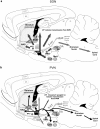From ultrasocial to antisocial: a role for oxytocin in the acute reinforcing effects and long-term adverse consequences of drug use?
- PMID: 18475254
- PMCID: PMC2442436
- DOI: 10.1038/bjp.2008.132
From ultrasocial to antisocial: a role for oxytocin in the acute reinforcing effects and long-term adverse consequences of drug use?
Abstract
Addictive drugs can profoundly affect social behaviour both acutely and in the long-term. Effects range from the artificial sociability imbued by various intoxicating agents to the depressed and socially withdrawn state frequently observed in chronic drug users. Understanding such effects is of great potential significance in addiction neurobiology. In this review we focus on the 'social neuropeptide' oxytocin and its possible role in acute and long-term effects of commonly used drugs. Oxytocin regulates social affiliation and social recognition in many species and modulates anxiety, mood and aggression. Recent evidence suggests that popular party drugs such as MDMA and gamma-hydroxybutyrate (GHB) may preferentially activate brain oxytocin systems to produce their characteristic prosocial and prosexual effects. Oxytocin interacts with the mesolimbic dopamine system to facilitate sexual and social behaviour, and this oxytocin-dopamine interaction may also influence the acquisition and expression of drug-seeking behaviour. An increasing body of evidence from animal models suggests that even brief exposure to drugs such as MDMA, cannabinoids, methamphetamine and phencyclidine can cause long lasting deficits in social behaviour. We discuss preliminary evidence that these adverse effects may reflect long-term neuroadaptations in brain oxytocin systems. Laboratory studies and preliminary clinical studies also indicate that raising brain oxytocin levels may ameliorate acute drug withdrawal symptoms. It is concluded that oxytocin may play an important, yet largely unexplored, role in drug addiction. Greater understanding of this role may ultimately lead to novel therapeutics for addiction that can improve mood and facilitate the recovery of persons with drug use disorders.
Figures


Comment in
-
Neuropharmacology of addiction--setting the scene.Br J Pharmacol. 2008 May;154(2):259-60. doi: 10.1038/bjp.2008.131. Epub 2008 Apr 14. Br J Pharmacol. 2008. PMID: 18414384 Free PMC article.
References
-
- Amico JA, Vollmer RR, Cai HM, Miedlar JA, Rinaman L. Enhanced initial and sustained intake of sucrose solution in mice with an oxytocin gene deletion. Am J Physiol Regul Integr Comp Physiol. 2005;289:R1798–R1806. - PubMed
-
- Aragona BJ, Liu Y, Yu YJ, Curtis JT, Detwiler JM, Insel TR, et al. Nucleus accumbens dopamine differentially mediates the formation and maintenance of monogamous pair bonds. Nat Neurosci. 2006;9:133–139. - PubMed
-
- Barr HM, Bookstein FL, O'Malley KD, Connor PD, Huggins JE, Streissguth AP. Binge drinking during pregnancy as a predictor of psychiatric disorders on the structured clinical interview for DSM-IV in young adult offspring. Am J Psychiatry. 2006;163:1061–1065. - PubMed
-
- Becker A, Grecksch G. Ketamine-induced changes in rat behaviour: a possible animal model of schizophrenia. Test of predictive validity. Prog Neuropsychopharmacol Biol Psychiatry. 2004;28:1267–1277. - PubMed
Publication types
MeSH terms
Substances
LinkOut - more resources
Full Text Sources
Other Literature Sources
Medical
Molecular Biology Databases

